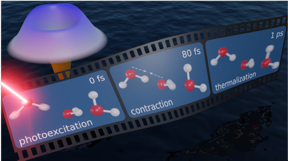Home > Press > Scientists capture a quantum tug between neighboring water molecules: Ultrafast electrons shed light on the web of hydrogen bonds that gives water its strange properties, vital for many chemical and biological processes
 |
| Schematic depiction of the quantum mechanical nature of water molecule interactions: excitation by a laser, followed by contraction of the hydrogen bond, then release of the energy (thermalization).
CREDIT Image courtesy of SLAC National Accelerator Laboratory. |
Abstract:
The Science
Water is the most abundant liquid in nature, but its also one of the least understood. Water has unusual properties. For example, most materials get denser when they get colder, but water is densest a few degrees above freezing. Thats why ice floats. Scientists suggest that waters so-called proton quantum effect may be at the heart of many of waters strange properties. This experiment with ultrafast electron diffraction marks the first time that scientists have directly observed this quantum effect in water. Scientists observed how the hydrogen atoms in water molecules tug and push neighboring molecules when water is excited with laser light. The results reveal quantum effects that could underpin key aspects of the microscopic origin of waters strange properties. This could lead to a better understanding of how water helps proteins function in living organisms
Scientists capture a quantum tug between neighboring water molecules: Ultrafast electrons shed light on the web of hydrogen bonds that gives water its strange properties, vital for many chemical and biological processes
Washington, DC | Posted on July 8th, 2022
The Impact
Each water molecule contains one oxygen and two hydrogen atoms. Water molecules are held together by a web of hydrogen bonds. In these webs, hydrogen and oxygen link in two ways. The hydrogen protons that are covalently bound (bonds involving atoms that share electrons) to oxygen in one molecule are also weakly attracted electrically to another oxygen in neighboring molecules. This intricate network drives many of waters strange properties. Researchers used short pulses of high-energy electrons to observe these interactions. This quantum effect could be the missing link in theoretical models describing the strange properties of water. It could also help to develop renewable energy methods using polymer membranes that transport hydrogen.
Summary
Many strange properties of liquid water, such as its density, which is greatest at 4 degrees Celsius and causes ice to float, originate from waters well-connected hydrogen bond network. A complete unveiling of the intermolecular dynamics of water requires direct time- and structure-resolved measurements. Neither X-rays nor neutron scattering can be used to study waters hydrogen bond structure dynamics due to the lack of scattering power (X-rays) or time resolution (neutrons). This research, by a team that included SLAC National Accelerator Laboratory, Stanford University, and Stockholm University, employed the MeV-UED instrument at the Linac Coherent Light Source (LCLS), a Department of Energy (DOE) user facility at SLAC. The MeV-UED instrument (for Megaelectronvolt Ultrafast Electron Diffraction) is a high-speed electron camera, a unique tool capable of investigating waters hydrogen bond structure dynamics. The experimental results reveal unique effects, such as how the contraction of the hydrogen bond emerges upon laser excitation. Revealing key aspects of the microscopic origin of waters strange properties could lead to a better understanding of how water helps proteins function in living organisms. Understanding the quantum behavior also could be important in modeling the many critical reactions that involve hydrogen, including carbon-hydrogen bond activation, water oxidation, carbon dioxide reduction, and acid-base chemistry critical for energy-related phenomena.
Funding
Development and operation of the Ultrafast Electron Diffraction (UED) instrument and the research reported here were supported by DOEs Office of Science, Basic Energy Sciences (Chemical Sciences, Geosciences, and Biosciences Division, Materials Sciences and Engineering Division, and Scientific User Facilities Division), and Fusion Energy Sciences as well as Stanford University fellowships. The UED is part of the Linac Coherent Light Source (LCLS), a DOE Office of Science user facility at SLAC National Accelerator Laboratory.
####
For more information, please click here
Contacts:
Michael Church
DOE/US Department of Energy
Office: 2028416299
Copyright © DOE/US Department of Energy
If you have a comment, please Contact us.
Issuers of news releases, not 7th Wave, Inc. or Nanotechnology Now, are solely responsible for the accuracy of the content.
Chemistry
News and information
![]()
Electrically driven single microwire-based single-mode microlaser July 8th, 2022
![]()
Deep-ultraviolet nonlinear optical crystals: Concept development and materials discovery July 8th, 2022
![]()
Optical demonstration of quantum fault-tolerant threshold July 8th, 2022
![]()
Photoinduced large polaron transport and dynamics in organic-inorganic hybrid lead halide perovskite with terahertz probes July 8th, 2022
Quantum Physics
![]()
Quantum network nodes with warm atoms June 24th, 2022
![]()
University of Illinois Chicago joins Brookhaven Lab’s Quantum Center June 10th, 2022
![]()
Bumps could smooth quantum investigations: Rice University models show unique properties of 2D materials stressed by contoured substrates June 10th, 2022
Quantum chemistry
![]()
University of Oklahoma scientists quantum technology work garners international attention February 11th, 2022
![]()
Examining recent developments in quantum chromodynamics: A new collection looks at recent development in the field of quantum chromodynamics from a range of perspectives December 24th, 2021
![]()
Putting a new theory of many-particle quantum systems to the test: Experiments show that generalized hydrodynamics accurately simulates an out-of-equilibrium quantum system September 3rd, 2021
![]()
Chaotic electrons heed limit in strange metals July 30th, 2021
Govt.-Legislation/Regulation/Funding/Policy
![]()
Photoinduced large polaron transport and dynamics in organic-inorganic hybrid lead halide perovskite with terahertz probes July 8th, 2022
![]()
Solving the solar energy storage problem with rechargeable batteries that can convert and store energy at once June 24th, 2022
![]()
Boron nitride nanotube fibers get real: Rice lab creates first heat-tolerant, stable fibers from wet-spinning process June 24th, 2022
Possible Futures
![]()
Luisier wins SNSF Advanced Grant to develop simulation tools for nanoscale devices July 8th, 2022
Discoveries
![]()
Photoinduced large polaron transport and dynamics in organic-inorganic hybrid lead halide perovskite with terahertz probes July 8th, 2022
Announcements
![]()
Luisier wins SNSF Advanced Grant to develop simulation tools for nanoscale devices July 8th, 2022
Water
![]()
Scientists offer solutions for risky tap water June 17th, 2022
![]()
UBCO researchers change the game when it comes to activity tracking: Flexible, highly sensitive motion device created by extrusion printing June 17th, 2022
![]()
Organic water splitters get a boost June 10th, 2022
![]()
The future of desalination? A fast, efficient, selective membrane for purifying saltwater May 13th, 2022
Quantum nanoscience
![]()
Bumps could smooth quantum investigations: Rice University models show unique properties of 2D materials stressed by contoured substrates June 10th, 2022
![]()
New hardware integrates mechanical devices into quantum tech April 22nd, 2022










